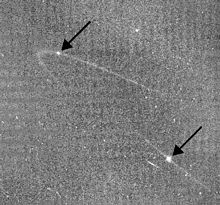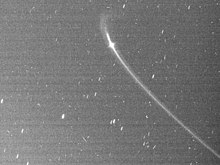Anthe (moon)
| Anthe | |
|---|---|
| Best shot of Anthe so far on January 30, 2016 by Cassini from a distance of 119,369 kilometers | |
| Provisional or systematic name | S / 2007 S 4 |
| Central body | Saturn |
| Properties of the orbit | |
| Major semi-axis | 197,700 km |
| Periapsis | 197,500 km |
| Apoapsis | 197,900 km |
| eccentricity | 0.0011 |
| Orbit inclination | 0.100 ° |
| Orbital time | 1.03650 d |
| Mean orbital velocity | 13.86 km / s |
| Physical Properties | |
| Albedo | ? |
| Apparent brightness | 26.0? like |
| Medium diameter | 1.8 km |
| Dimensions | 1.4987 · 10 12 kg |
| surface | 10, l2 km 2 |
| Medium density | 0.5 g / cm 3 |
| Acceleration of gravity on the surface | 0.00012 m / s 2 |
| Escape speed | 0.55556 m / s |
| discovery | |
| Explorer |
Cassini Imaging Science Team |
| Date of discovery | May 30, 2007 |
Anthe (also Saturn XLIX ) is the twelfth and one of the smallest of the 82 known moons of the planet Saturn . Their orbit lies between those of the great moons Mimas and Enceladus, and the moons of this section, which also includes Methone and Pallene , are called the alkyonid group .
discovery
The discovery of Anthe by the Cassini Imaging Science Team on images taken on May 30, 2007 and earlier images dating back to June 2004 was announced on July 18, 2007. Anthe is the 60th confirmed moon in the Saturn system.
Anthe was initially given the provisional designation S / 2007 S 4 and was unofficially called Frank by its discoverers . In August 2007 the moon was named after one of the seven daughters of the giant Alkyoneus from Greek mythology (Alkyonids). Alkyoneus was a son of Gaia and the blood of Uranus . The giant was killed in the giant battle by Herakles . Anthe and her six sisters (including Methone and Pallene) were so mournful over the death of their father that they threw themselves from the Canastrian foothills into the sea. But out of pity, the Oceanid (or Nereid ) Amphitrite saved their lives and turned them into kingfishers .
Track properties
Orbit
Anthe orbits Saturn in a prograde , almost perfectly circular orbit at an average distance of 197,700 km (approx. 3,280 Saturn radii) from its center, i.e. about 137,430 km above its cloud ceiling. The orbit eccentricity is 0.0011, the orbit is inclined 0.1 ° to the equator of Saturn , so it is almost in the equatorial plane of the planet. Due to the low eccentricity, the orbit varies by about 400 km in the distance to Saturn.
The orbit of the next inner moon Methone is on average about 3,260 km from the orbit of Anthe, the distance of the orbit of the next outer moon Pallene is on average about 14,600 km.
Anthe orbits Saturn in 1 day, 0 hours, 52 minutes and 33.6 seconds. It takes 38.8 minutes longer than its inner neighbor Methone to complete one cycle. It covers a distance of 347 ° in 24 hours.
Anthe is in a 10:11 orbit resonance with the inner moon Mimas . This severely disrupts their orbit of mimas . The much larger Mimas causes deviations in the Methone orbit of about 200 km due to its gravity. The influence of the orbit resonance also means that Methone moves back and forth on its orbit at a length of 14 °.

Anthe ring arch
Despite the small size of Anthe, a ring system was discovered in front of and behind it in June 2007. However, this does not form a closed system around Saturn, but extends only a few thousand kilometers in front of and behind Methone and moves with it. It is believed that the arches of Anthe and Methone were probably formed from material that was knocked out of these two moons by micrometeorites . The gravitational resonance with mimas keeps them in their shape; Mimas prevents the ring material from spreading over the entire orbit like the other Saturn rings and forming a uniform ring.
Physical Properties

Anthe has a diameter of about 1.8 km. With an average density of 0.5 g / cm 3 , the mass is 1.4987 · 10 12 kg. On its surface, the acceleration due to gravity is 0.00012 m / s 2 , which corresponds to only about 0.01 ‰ of that on earth.
So far there have been two theories about the origin of the three closely spaced moons Methone, Anthe and Pallene : First, they were broken out by either Mimas or Enceladus through a collision with a comet or asteroid , and second , all of these five moons could even be residues of a larger swarm, who wandered to this near region of Saturn.
exploration
Anthe has an apparent magnitude of 26.0 m , which is 1: 13000000000 of the central planet. Methone has so far been visited by four space probes , namely by the flyby probes Pioneer 11 on September 1, 1979, Voyager 1 on November 12, 1980 and Voyager 2 on August 25, 1981 (these took place without sighting the moon) and finally Cassini-Huygens .
Since its discovery in 2007, its orbit parameters have been made more precise by the Cassini probe, which has been orbiting Saturn since July 1, 2004.
media
Web links
- IAUC 8857: S / 2007 S 4 July 18, 2007 (discovery)
- IAUC 8873: Satellites of Saturn September 20, 2007 (numbering and naming)
- Saturn turns 60 press release by the JPL (English)
Individual evidence
- ↑ Paul Rincon: Saturn overtakes Jupiter as planet with most moons. BBC , October 7, 2019, accessed March 20, 2020 .
- ↑ http://www.astronews.com/news/artikel/2009/06/0906-030.shtml
- ↑ Anthe: Overview ( Memento from May 31, 2015 in the Internet Archive )
| further inside | Saturn moons | further outside |
| Methone |
Large semi-axis (km) Anthe 197.700 |
Pallene |


